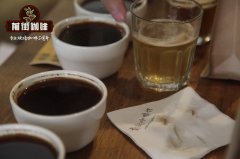Introduction of Beneficio Brumas del Zurqui of Blooms processing Plant in Costa Rica

Professional coffee knowledge exchange more coffee bean information please follow the coffee workshop (Wechat official account cafe_style)
The Beneficio Brumas del Zurqui was founded in 1880 by the Rodri í guez Carballo family and is now run by Juan Ram ó n Alvarado Rodr í guez. Finca Dona Clemencia is a new estate he bought three years ago, renamed Dona Clemencia in memory of his mother, Rodri.
The estate, which has only one hectare of geisha breeds (Geisha), has just had a small harvest in 2017 and won 28th place in the Costa Rican COE Cup.
In 2002, when Juan Ram ó n Alvarado Rodr í guez first set up a processing plant in the Central Valley (Central Valley), there were only three small processing plants in the region. Including his treatment plant, Costa Rica has a long history of growing coffee, but in the past 10 years, a new "dry" treatment method has become popular, collectively known as "honey treatment", the function of using scrapers to adjust the scraping degree of pulp. With the color from light to dark (white, yellow-red-white, yellow-red-black), the output presents a "honey feeling" from light to strong, with acidity and complex aroma. Each has its own depth and advantages. Honey treatment started in Costa Rica, while Costa Rica has also developed a micro-processing plant (micro mill) coffee characteristic development, the main feature development is the hope that each small farm can have its own system for handling beans, so that the processing can be done by the farm itself, and the best specialty coffee raw beans can be produced according to their own unique process. Finca Brumas del Zurqui Manor has its own family-owned raw bean processing plant, which originally means "misty valleys". In addition to growing coffee, the estate also helps produce nearby estates and coffee farmers. He began to grow coffee in 1880, and in 2006, Brumas won the champion of the Costa Rican National Coffee Competition. The "honey treatment method" of the manor was immediately valued by bean merchants all over the world. So since 2007, Brumas coffee beans have always been snapped up before the competition.
Juan Ramon Alvarado and Natalia Gomez Manor is a miniature water treatment plant established in 2002 by the Juan Ramon Alvarado and Natalia Gomez family. The family has been engaged in coffee cultivation and production for more than a century. In particular, Juan Ramon Alvarado is the leader in honey coffee processing technology. In 2016, the COE Cup in Costa Rica was awarded the third runner-up treatment plant. In 2015, El Beneficio, the estate of family member Natalia Gomez, won the second place in the COE competition through the experience of the Brumas processing plant in honey processing technology. It is no accident that his family manor and processing plant technology became famous. Juan Ramon Alvarado he currently has several estates (Zamora) and Baby (La Nena) as well as others. Coffee varieties are bourbon, Kaddura (caturra), geisha and others.
Qianjie recommended cooking parameters:
Hand punch: V60 filter cup small Fuji R440 grinding 3.5, water temperature about 90 degrees
The recommended grinding degree of normal pressure is 4 and the water temperature is 90 ℃.
The recommended siphon grinding degree is 4, and the water temperature is 90 ℃ ~ 91 ℃.
The pressure grinding degree of Philharmonic is recommended to be 3.5, and the water temperature is 90 ℃.
Important Notice :
前街咖啡 FrontStreet Coffee has moved to new addredd:
FrontStreet Coffee Address: 315,Donghua East Road,GuangZhou
Tel:020 38364473
- Prev

Can Costa Rican coffee be made by hand at La Minita Manor, Costa Rica?
For more information on coffee beans, please follow the Coffee Workshop (Wechat official account cafe_style) La Minita International Coffee Export Company, named after the flagship Hacienda La Minita estate in Tarazhu, Costa Rica. In addition to the flagship manor in Costa Rica, Raminita also offers products from all over the world.
- Next

Characteristics of West Valley cultivation in Costa Rica Coffee producing area-Western Valley / Western Valley
Professional coffee knowledge exchange more coffee bean information please follow the coffee workshop (Wechat official account cafe_style) Costa Rica coffee producing area: the seven main coffee producing areas are distributed from northwest to southeast along with the inland central plateau. The Costa Rican volcanic terrain has fertile volcanic ash, mild and suitable temperature, and stable and abundant rainfall.
Related
- Does Rose Summer choose Blue, Green or Red? Detailed explanation of Rose Summer Coffee plots and Classification in Panamanian Jade Manor
- What is the difference between the origin, producing area, processing plant, cooperative and manor of coffee beans?
- How fine does the espresso powder fit? how to grind the espresso?
- Sca coffee roasting degree color card coffee roasting degree 8 roasting color values what do you mean?
- The practice of lattes: how to make lattes at home
- Introduction to Indonesian Fine Coffee beans-- Java Coffee producing area of Indonesian Arabica Coffee
- How much will the flavor of light and medium roasted rose summer be expressed? What baking level is rose summer suitable for?
- Introduction to the characteristics of washing, sun-drying or wet-planing coffee commonly used in Mantenin, Indonesia
- Price characteristics of Arabica Coffee Bean Starbucks introduction to Manning Coffee Bean Taste producing area Variety Manor
- What is the authentic Yega flavor? What are the flavor characteristics of the really excellent Yejasuffi coffee beans?

